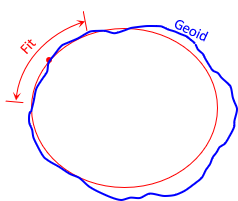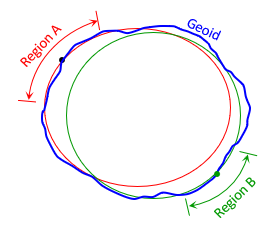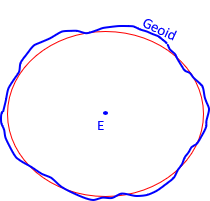Chapter F. Ellipsoid Fitting
1. Type of Fits
Because measurements are referenced to the geoid, an ellipsoid is selected and fit to it. The geoid is irregular (and changes over time) so no single ellipsoid fits it perfectly. Fitting an ellipsoid requires some degree of compromise.
a. Regional Fit
One approach is to fit an ellipsoid to a specific region of the geoid. Figure F-1.
 |
| Figure F-1 Regional Ellipsoid Fit |
A point located centrally in the region is used as the fit origin. The ellipsoid and geoid coincide at this point - they are parallel with no vertical separation between them. Parameters that are fixed are:
- Fit origins geodetic latitude and longitude
- Azimuth of a line from the origin point
- Two ellipsoid parameters
Making the geoid and ellipsoid coincide assumes the two surfaces do not separate significantly throughout the area. This was a reasonable assumption for an early datum definition before a good mathematical geoid model was available. The error introduced wasn't significant for most surveys.
Different regions would use their own ellipsoid sizes and fits to meet their needs, Figure F-2.
 |
| Figure F-2 Multiple Fits |
Of course, what fit one area wouldn't fit well anywhere else. That was of little consequence before global measurements were possible.
b. Global fit
Evolution of global measurement systems required developing models that weren't limited to regions. A geocentric ellipsoid, Figure F-3, was needed.
 |
| Figure F-3 Geocentric Fit |
The ellipsoid is fit by:
- Setting ellipsoid center at Earth's mass center
- Fixing orientation of the semi-major and -minor axes
- Specifying two geometric ellipsoid attributes